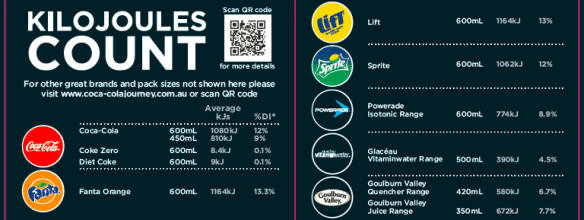.jpg)
Offering Choice and Information
07-08-2017
Coca‑Cola South Pacific markets 25 brands owned by The Coca‑Cola Company in Australia. These brands feature on more than 165 products sold in thousands of outlets across the country.
Brands belonging to The Coca‑Cola Company are prepared, packaged, distributed and sold by our bottling partner Coca‑Cola Amatil at 12 bottling plants across the country. Our Australian factories produce 99% of our non-alcoholic beverages.
While Coca‑Cola Amatil also owns a number of brands, including Mount Franklin water, we work closely together to market and sell the combined portfolio of brands.
As a significant Australian business responsible for global brands, we take corporate responsibility seriously. Our marketplace actions have been implemented to address a key community concern: obesity. In Australia our focus is on two fundamental principles: provide more beverage choices and provide more information.
Provide more beverage choices
We have invested significant time and resources in recent years to innovate some of TCCC’s most popular drinks, providing consumers with greater choice.
We know that while many people want to reduce their kilojoule and sugar intake, they do not want to compromise on taste. This is a difficult balance to achieve but is something we work hard to get right.
1. More choices of lower kilojoule options
Diet Coke was introduced to Australians in 1983 as was one of TCCC’s first no-sugar, low-kilojoule colas.
By the end of 2014, all TCCC’s top selling brands in Australia had a low-kilojoule alternative, including Coca‑Cola, Sprite, Fanta, and Powerade.
Coca‑Cola South Pacific has reduced sugar across 25 of our drinks since 2015, and we think we’ll take 20% of the sugar from across our range by 2025.
2. More choices of smaller serving options
For people who want to reduce their sugar and kilojoule intake but still enjoy their beverage of choice, we’re working with bottling partner Coca‑Cola Amatil to increase the range of smaller portion sizes.
We are focused on ensuring that smaller portions are available in more stockists throughout Australia.
Our 250ml variants are available in 70% of convenience stores and petrol stations across Australia. We’ve also made smaller servings available in 81% of grocery retailers, and introducing 390ml bottles to replace the larger 450ml bottles in the majority of our stockists.

Providing more information for our consumers
A key priority for us is to provide our consumers with the clearest possible nutrition information about our beverages. This helps people choose the best option for themselves and their families. We have long been committed to providing clear and transparent nutritional labelling so that people can make informed choices about our products.
1. Clear, transparent labelling on pack

We voluntarily introduced the % Daily Intake Guide label on all our products in 2007. This provides clear information on both the amount of kilojoules per serve and what this represents as a percentage of the total recommended daily energy intake for an adult.
In 2014 we committed to adopting the Government’s voluntary Health Star Rating System (HSR) to assist consumers in making informed choices. The beverage category is part of the integrated HSR approach and as such needs to have a minimum display requirement of energy (kilojoules) only.
2. Clear, transparent labelling on vending machines
More recently we introduced nutrition information panels on our vending machines, reaching 75% by the end of 2015.
We’ve introduced nutrition labelling to the majority of our vending machines.

3. Responsible Marketing practices
We have important policies for our marketing practices to ensure we provide meaningful and responsible information for our Australian consumers.
The Coca‑Cola Company has a long-standing policy not to market beverages to children. As of 2019 this includes anyone under the age of 15.
We do not buy advertising targeted at audiences that are made up of more than 35% children under 15 years old.
This policy applies to television, radio, and print, and, where data is available, to the Internet and mobile phones.
We also believe in commercial free schools. In 2010 we introduced Global School Beverage Guidelines and have committed to not commercially advertise in, or within 300 meters of primary or secondary schools.
In primary schools, we do not offer our beverages for sale unless requested by a school authority. We retain records of sales to primary schools which are audited annually.
In secondary schools, we work with school authorities to ensure an appropriate range of beverages is made available – including water, juices and other drinks, in accordance with the relevant State and National school guidelines around Australia.
The future of informed choices
We’ll continue to work on ways to promote more choice for consumers, and we look forward to bringing news of these to the public as they roll out.
Read Time
What others are reading
More to enjoy
.jpg)